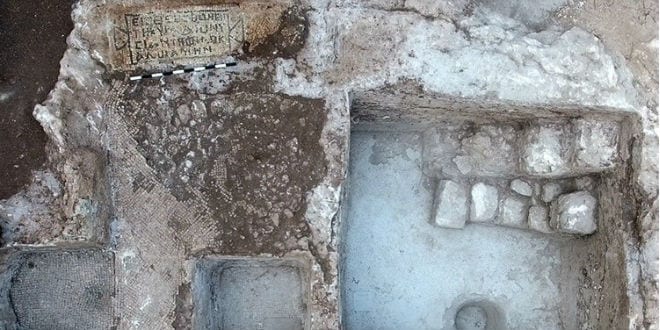The Israel Antiquities Authority (IAA) discovered a 1,600-year-old inscription recording the blessing of a wealthy Samaritan owner. The inscription was in an excavation being made of a new neighborhood at Tzur Natan in Samaria in central Israel.
“Only God help the beautiful property of Master Adios, amen,” the inscription read in Greek. Adios was apparently the name of the wealthy estate owner.
Prof. Leah Di Segni of the Hebrew University of Jerusalem deciphered and translated the inscription which was dated to the early fifth century CE. At that time, the Samaritan settlement was at the height of its power and prosperity in the region.
The Samaritans are an ethnoreligious group claiming descent from the tribes of Ephraim and Manasseh, as well as from the Levites. Though they consider themselves to be an offshoot of Judaism, Samaritans believe that their worship is the true religion of the ancient Israelites from before the Babylonian captivity. The major issue between Jews and Samaritans has always been the location of the Chosen Place to worship God: The Temple Mount in Jerusalem according to the Jewish faith or Mount Gerizim according to the Samaritan faith.
During the Byzantine period, the Samaritans revolted against the government in an attempt to maintain their identity. After the revolts, the community diminished in size and returned to the Mount Gerizim area. A Samaritan community still lives at Mount Gerizim, as well as in the city of Holon, south of Tel Aviv.
Dr. Hagit Torge, director of the excavations on behalf of the IAA, described the conditions surrounding the discovery.
“The inscription was discovered in an impressive wine press that was apparently part of the agricultural estate of a wealthy individual called Adios,” Dr. Torge said in a statement. “This is only the second such wine press discovered in Israel with a blessing inscription associated with the Samaritans. The first was discovered a few years ago in Apollonia near Herzliya.”
Near the wine press, the archaeologists identified stone quarries with rock-cut depressions used for cultivating grapevines. These were presumed to be part of “Master Adios” estate.
“’Master’ was an honorific given to senior members of the community and attests to the high social standing of the owners of the estate,” Dr. Torge said. “The location of the wine press is near the top of Tel Tzur Natan, where remains of a Samaritan synagogue were found with another inscription, and reveals Adios’ high status.”
The Tzur Natan Samaritan synagogue was transformed into a church in the sixth century. A compound was discovered nearby in the past, featuring large rooms and spaces for producing wine, oil, and flour. In one of these, a Pompeian donkey mill was found, used to grind flour and incised with a seven-branch candelabrum.
Source: Israel in the News

